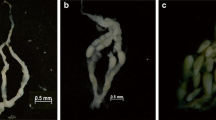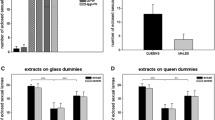Summary
-
1.
The caste plasticity of overwintered final instar female larvae ofMyrmica rubra has been established.
-
2.
A method of rearing single larvae so that series of observations on growth and development can be made on living specimens has been described.
-
3.
The movement of the larval brain and the development of the imaginal leg buds have been used as indices of maturity. Larval weight, and the development of the wing bud and of the ovary have been used as indices of femininity.
-
4.
The ontogenies under optimal culture conditions of queen-forming female larvae and of male larvae have been established. These will be used as standards for the comparison of worker and intercaste ontogenies.
Résumé
-
1.
Les larves du dernier stade de développement deMyrmica rubra mises en élevage après l'hiver, peuvent devenir reines ou ouvrières.
-
2.
On signale une méthode d'élevage individuel des larves, afin de faciliter des séries d'observations sur la croissance et sur le développement.
-
3.
Le déplacement des ganglions cérébroïdes et le développement des pattes des larves ont été employés comme indices de maturité. Le poids larvaire, le développement de l'aile et le développement de l'ovaire ont été employés comme indice de féminité.
-
4.
On a étudié l'ontogenèse des reines et celle des mâles dans les conditions optimales d'élevage. Les résultats obtenus ont servi de bases de comparaisons pour l'étude ontogénétique des ouvrières et des intercastes.
Zusammenfassung
-
1.
Die Plastizität der Gesellschaftsklasse der überwinternden in der letzten Entwicklungsphase sich befindenden sternförmigen weiblichen Larven derMyrmica rubra ist festgestellt worden.
-
2.
Eine Methode, einzelne Larven zu züchten, sodass eine Reihe von Beobachtungen bezüglich Wachstum und Entwicklung an lebenden Exemplaren gemacht werden kann, ist beschrieben worden.
-
3.
Die Bewegung des Larvengehirns und die Entwicklung der imaginalen Keimscheiben der Beine sind als Nachweis der Maturität benutzt worden. Das Larvengewicht und die Entwicklung der Keimscheiben der Flügel und des Eierstockes haben zum Nachweis der Weiblichkeit gedient.
-
4.
Die Ontogenie—beim Vorhandensein günstigster Kulturbedingungen—der die Königinnen bildenden weiblichen Larven und der männlichen Larven ist festgestellt worden. Diese wird den Maßstab für den Vergleich der Ontogenie zwischen der Arbeiter- und Zwischenklasse bilden.
Similar content being viewed by others
Références
1951.Bernard (F.). — Déterminisme des castes, dansTraité de Zoologie,10, 1097–1104, Masson et Cie Paris.
1952.Bier (K.). — Beziehungen zwischen Nährzellkerngrösse und Ausbildung ribonukleinsäurehaltiger Strukturen in den Oocyten vonFormica rufa rufo-pratensis minor Gösswald. (Verh. Zool. Ges. Freiberg,24, 369–374).
1949.Brian (M. V.) andBrian (A. D.). — Observations on the taxonomy of the antsMyrmica rubra L. andM. lævinodis Nylander (Trans. R. ent. Soc. Lond.,100, 393–409).
1950.Brian (M. V.). — The stable winter population structure in species ofMyrmica. (J. Anim. Ecol.,19, 119–123).—Brian (M. V.). 1951. Caste determination in a Myrmicine ant (Experientia,7, 182).—Brian (M. V.). 1952. Further work on caste determination inMyrmica (Bull. Union internationale pour l'étude des Insectes sociaux,1, 17–20).—Brian (M. V.). 1953. Brood rearing in relation to worker number in the antMyrmica (Physiol. Zöol.,26, 355–366).
1891.Bugnon (E.). — Rechérches sur le développement post-embryonnaire, l'anatomie et les mœurs de l'Encyrtus fuscicollis. (Rev. Zool. Suisse,5, 435–536).
1878.Dewitz (H.). — Beitrage zur postembryonalen Gliedmassenbildung bei den Insecten (Z. wiss. Zool.,30, 78–105).
1953.Eassa (Y. E. E.). — The development of imaginal buds in the head ofPieris brassicæ L. (Trans. R. ent. Soc. Lond.,104, 39–50).
1923.Ezhikov (I.). — Ueber den Charaketer der Variabilität der Ameisen-Ovarien (Revue Zool. Russe,3).—Ezhikov (I.). 1926. Ueber den Polymorphen Veränderungen der Korpergrösse bei den Ameisen (Ark. des Timiriazew Inst., Moscow).—Ezhikov (I.). 1929. Zur vergleichenden Œkologie der Sozialen Insekten (Ark. des Timiriazew Inst., Moscow). —Ezhikov (I.). 1934. Individual variability and dimorphism of social insects (Amer. Nat. 68, 333–344).
1876.Ganin (M.). — Materialen zur Kenntnis der post-embryonalen Entwicklungsgeschichte der Insekten (Russian) (Abstract byHoyer inZ. wiss. Zool.,28, also inAmer. Nat.,11, 423–430).
1939.Gœtsch (W.). — Die Staaten argentinischer Blattschneiden Ameisen (Zoologica, Stuttgart,96, 1–105).—Gœtsch (W.). 1946. Vitamin T, ein neuartiger Wirkstoff (Œsterr. Zool. Zeits,1, 49–57).—Gœtsch (W.). 1947. Der Einfluss von Vitamin T auf Gestalt und auf Gewohnheiten von Insekten (Œsterr. Zool. Zeits.,1, 193–274).—Gœtsch (W.). 1948. Die Wirkung von Vitamin T bei Vertebraten (Œsterr. Zool. Zeits.,1, 533–626).
1953.Gösswald (K.) andBier (K.). — Untersuchungen zur Kastendetermination in der GattungFormica (Naturwiss.,40, 38–39).
1942.Gregg (R. E.). — The origin of castes in ants with special reference toPheidole morrisi Forel (Ecology,23, 295–308).
1902.Janet (C.). — Anatomie du gaster de laMyrmica rubra, Paris, Carré et Cie, 68 pages.
1898.Karawaiew (W.). — Die nachembryonale Entwicklung vonLasius flavus (Z. wiss. Zool.,64, 385–478).
1950.Ledoux, (A.). — Recherches sur la biologie de la Fourmi fileuse (Œcophylla longinoda Latr.) (Ann. Sc. Nat. Zool.,12, 313–461).
1942.Light (S. F.). — The determination of the castes of social insects (Quart. Rev. Biol.,17, 312–326, and18, 46–63).
1945.Medawar (P. B.). — Size, shape, and age (inGrowth and Form, Oxford Univ. Press).
1886.Nassanow (N.). — Zur postembryonalen Entwicklung der AmeiseLasius flavus (Russian) (Sitzungber. zoolog. Anth. Gesell. Freunde Naturwiss.,1, 1–42).
1930.Œrtel (E.). — Metamorphosis in the honey-bee. (J. Morph. and Physiol.,50, 295–332).
1950.Peacock (A. D.) andBaxter (A. T.). — Studies in Pharaon's antMonomorium pharaonis L. Pt. 3, Life History (Ent. mon. Mag.,86, 171–178).
1832.Ratzeburg (J. T. C.). — Ueber Entwicklung der Fusslosen Hymenopteren-Larven, mit Besonderer Rücksicht auf die GattungFormica (Nova Acta Natur. Curios.,15, 145–176).
1953.Richards (O. W.). —The social insects, Macdonald, London.
1933.Sanderson A. R.). — The cytology of parthenogenesis inTenthredinidæ (St. Andrew's Univ. Pub.,33, 321–451).
1952.Schneirla (T. C.) andBrown (R. Z.). — Sexual broods and the production of young queens in two species of army ants. (Zoologica, New-York,37, 5–32).
1922.Tiegs (O. W.). — Researches on the insect metamorphosis (Trans. R. Soc. S. Australia,46, 319–527).
1940.Wesson (L. G.). — An experimental study of caste determination in ants (Psyche, Cambridge Mass.,47, 105–111).
1928.Weyer (F.). — Untersuchungen bei Hymenopterenarbeiterinnen (Z. wiss. Zool.,131, 345–501).
1910.Wheeler (W. M.). —Ants., Columbia Univ. Press.
1953.Wilson (O. W.). — The origin and evolution of polymorphism in ants. (Quart. Rev. Biol.,28, 136–156).
1916.Zander (E.). — Die Ausbildung des Geschlechtes bei der Honigbiene. (Z. Angew. Ent.,3, 1–74).
Author information
Authors and Affiliations
Rights and permissions
About this article
Cite this article
Brian, M.V. Studies of caste differentiation inMyrmica rubra L.. Ins. Soc 1, 101–122 (1954). https://doi.org/10.1007/BF02223033
Issue Date:
DOI: https://doi.org/10.1007/BF02223033




